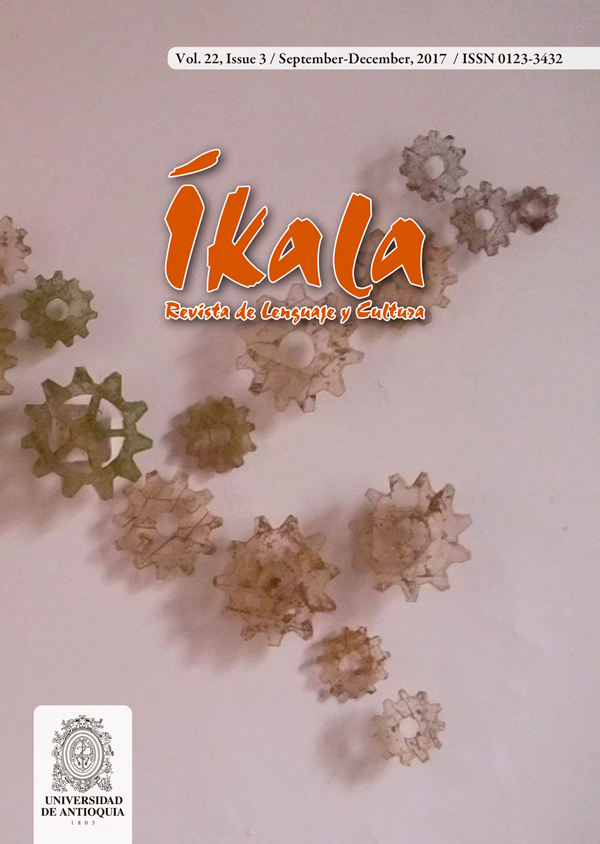Conversational Markers in Government-provided Interpretation Services: A Matter of Omissions and Additions
DOI:
https://doi.org/10.17533/udea.ikala.v22n03a02Keywords:
conversational markers, interpretation in public services, intercultural mediation, discourse markersAbstract
According to Wang (2013, p. 130), conversational markers are linguistic elements performing a double role: informational and interactive. In their second role, they are used to regulate interaction between participants in a conversation, in transitioning to another topic, when stating speaker’s attitude, and so on. Therefore, they perform a significant role in any oral exchange. However, what does it happen to conversational markers when that oral exchange is made possible by an interpreter? In research on public service interpreting, the study of conversational markers has been rather anecdotal and, unless some exceptions within the judicial sphere, our knowledge on the treatment this discourse markers receive in interpreting is scarce. This paper presents the study of a conversation interpreted by a mediator-interpreter in public services in the language pair Chinese-Catalan, which was recorded and subsequently transcribed verbatim in order to make analysis easier. The results reflect la omission of all conversational markers the primary interlocutors (a high school teacher and a Chinese student’s mother) had been using, as well as the addition, by the mediator-interpreter, of conversational markers that were absent in the original message. In the conclusions, I reflect upon the potential implications of these results, and on the prospective value of this study.
Downloads
References
Blas Arroyo, José Luis. (1995). La interjección como marcador discursivo: el caso de “eh”. Anuario de Lingüística Hispánica, XI, 81-117. Recuperado de: http://hdl.handle.net/10234/80908
CRIT, grupo (ed.) (2014). La práctica de la mediación interlingüística e intercultural en el ámbito sanitario. Granada: Comares.
Friedman-Rhodes, Elisabeth, y Hale, Sandra. (2010). Teaching Medical Students to work with Interpreters. JoSTrans, 10, 121-144. Recuperado de: http://www.jostrans.org/issue14/art_friedman.pdf
Gallai, Fabrizio. (2013). Understanding discourse markers in interpreter-mediated police interviews (Tesis doctoral), University of
Salford. Recuperado de: http://usir.salford.ac.uk/30671/
García-Beyaert, Sofía. (2013). Código deontológico: principios éticos y pautas de buenas prácticas para la interpretación en los servicios públicos y el ámbito comunitario. Recuperado de: http://www.l-in-k.org/Codigo_deontologico_ISPC.pdf
García-Beyaert, Sofía; Bancroft, Marjory A.; Allen, Katharine; Carriero-Contreras, Giovanna, y Socarrás-Estrada, Denis. (2015). Ethics and Standards for the Community Interpreter. An International Training Tool. En Marjory A. Bancroft (ed.), The Community Interpreter: An International Textbook. Columbia, Maryland: Culture and Language Press.
García-Beyaert, Sofía; Serrano Pons, Jordi. (2009). Recursos para superar las barreras lingüístico-culturales en los servicios de salud. En J. Morera; A. Alonso y H. Huerga (eds.) Manual de atención al inmigrante. Madrid, Ergón. Recuperado de: http://www.l-in-k.org/Garcia-Beyaert-2009-Recursos-para-superar-barreras-ling-cult-en-salud.pdf
González, Montserrat. (1998). Bé i bueno. Apunts sobre l’ús dels marcadors discursius. En L. Payrató et al. (eds.). Oral-ment. Estudis de variació funcional, 1-4. Barcelona: Publicacions de l’Abadia de Montserrat.
González, Montserrat. (2001). Els marcadors pragmàtics compostos en el relat oral anglès i català. Caplletra, 30, 73-94. Recuperado de: http://www.raco.cat/index.php/Caplletra/article/view/285363/373262
González, Montserrat. (2005). Pragmatic markers and discourse coherence in English and Catalan oral narrative. Discourse Studies, 7(1), 53-86.
Hale, Sandra. (1999). Interpreters’ treatment of discourse markers in courtroom questions. Forensic Linguistics, 6(1), 57-82.
Martín Peris, Ernesto. (dir.) (2007). Diccionario de términos clave de ELE. Centro Virtual Cervantes. Recuperado de: http://cvc.cervantes.es/Ensenanza/biblioteca_ele/diccio_ele/default.htm
Martín Zorraquino, María Antonia y Montolío, Estrella. (1998). Los marcadores del discurso. Teoría y análisis, Madrid: Arco Libros.
Martín Zorraquino, María Antonia y Portolés, José. (1999). Los marcadores del discurso. En I. Bosque y V. Demonte (dirs.), Gramática descriptiva de la lengua española, capítulo 64. Madrid: Espasa Calpe.
Obis Monné, Aina. (2014). Inicidencia de la interacción entre aprendices en el aprendizaje de los marcadores discursivos en el ámbito académico universitario. Revista electrònica de lingüística aplicada, 1, 133-156.
Ortega Olivares, Jenaro. (1985). Apéndices modalizadores en español: los «comprobativos». En J. Montoya Martínez y J. Paredes Núñez (eds.). Estudios románicos dedicados al prof. Andrés Soria
Ortega, 239-255. Granada: Universidad de Granada.
Payrató, Lluís. (2016). Estudis de pragmàtica i anàlisi del discurs sobre la llengua catalana: un repàs de l’etapa 1997-2012. Estudis Romànics, 38, 55-88.
Pöchhacker, Franz. (2015). Routledge Encyclopedia of Interpreting Studies. Abingdon: Routledge.
Portolés, José. (1998). Marcadores del discurso, Barcelona: Ariel.
Rovira-Esteva, Sara. (2010). Lengua y escritura chinas. Mitos y realidades. Barcelona: Edicions Bellaterra.
Schiffrin, Deborah. (1987). Discourse markers. Cambridge: Cambridge University Press.
Sperber, Dan y Wilson, Deirdre. (1986). Relevance: Communication and Cognition. Oxford: Wiley-Blackwell.
Vargas-Urpi, Mireia. (2012). State of the Art in Community Interpreting Research. Mapping the main research topics. Babel, 58(1), 50-72.
Vargas-Urpi, Mireia. (2013). ISP y/o mediación intercultural: la realidad de los profesionales que trabajan en el contexto catalán. Cuadernos de Aldeeu, 25, 131-164. Recuperado de: http://aldeeu.org/cuadernos/index.php/CALDEEEU/article/view/38
Wadensjö, Cecilia. (1998). Interpreting as interaction. London: Longman.
Wang, Yi-Chen. (2013). Los marcadores conversacionales en el subtitulado del español al chino: análisis de La mala educación y Volver de Pedro Almodóvar (Tesis doctoral). Universitat Autònoma de Barcelona. Recuperado de: http://hdl.handle.net/10803/125655
Downloads
Published
How to Cite
Issue
Section
License
Copyright (c) 2017 Íkala

This work is licensed under a Creative Commons Attribution-NonCommercial-ShareAlike 4.0 International License.












